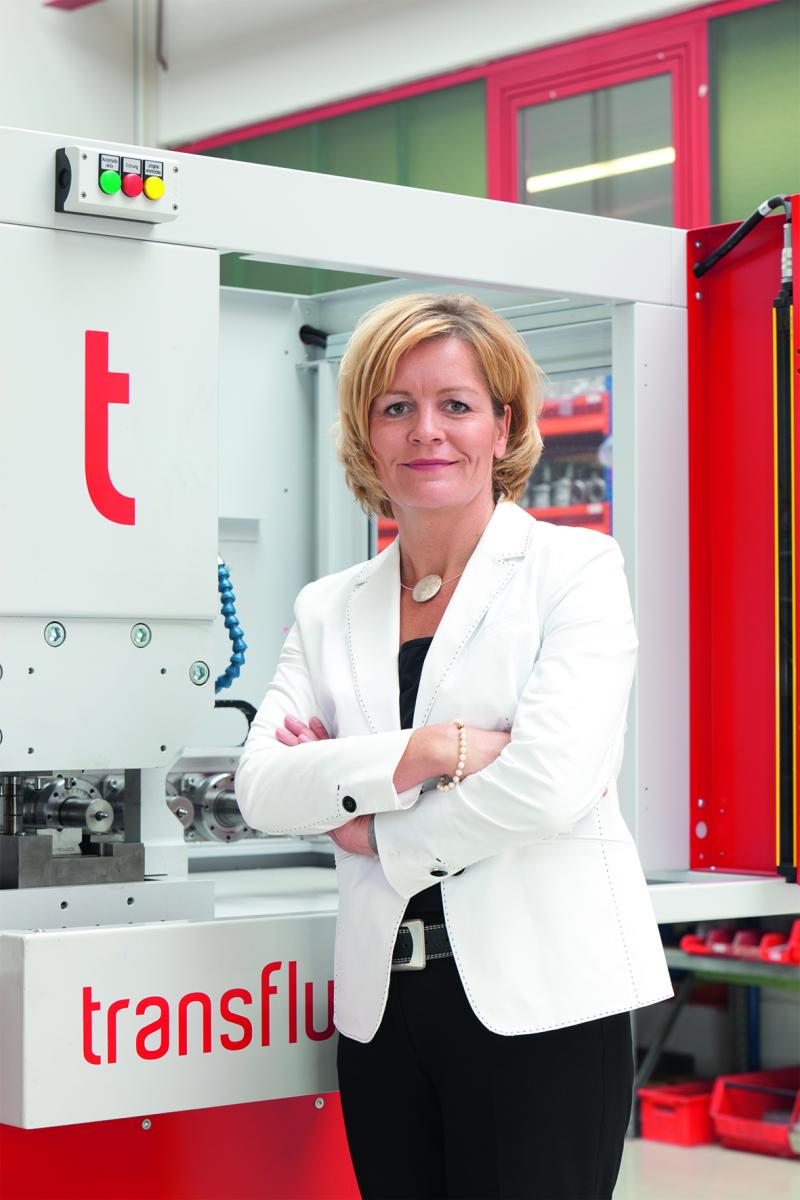Global high-tech companies are melding Industry 4.0, automation and big data to create metalworking equipment, tools and solutions that will build empires in the industrial manufacturing. They are eedeveloping healthy ecosystems that can carry their strategies and values far.
Whatever the situation, Industry 4.0 is here, and manufacturers all over the world are doing their best to prepare. At this issues 2018 Outlook Report, industry leaders and senior executives share their views and initiatives on Industry 4.0, and the current and future of metalworking industry, as part of their overall efforts toward automation and big data in manufacturing.
Stefanie Flaeper, Managing Director at transfluid

Anyone who considers the changes with some foresight is on a good path to a positive future. High-tech for effective pipe processing is the key to progress for many technologies and an important solution driver in all area of daily work and life, for example, when you consider machine and medical technology. Over the course of digital development, we also discovered completely new solutions, which ensure even more efficiency in heavily connected processes. Like I said, anyone who’s forward-thinking and is ready to approach digitalisation challenges and the accompanying shift in thinking openly will be successful. The demand will continue to grow together with increasing productivity. We’re already witnessing this development, for example, with our individual automation systems t motion and our tube bending software t control.
The relevance of highly rigid materials in lightweight construction continues to increase. In the automobile area, the trend is developing towards low quantities together with flexible automatic production, i.e. small quantities and individual pieces in automatic processes. This results in advantages like employee-independent production, process reliability, and influence on traceable processes, for example module assembly. Overall, there’s more planning reliability. Of course, the potential for mechanical engineering is being defined worldwide by automation and digitalisation. I see the clearest opportunities and chance to grow in this area. We’re expanding these trends ourselves with our own innovative power.
QUAH Beng Chieh, Head of Marketing (Asia Pacific), FARO Technologies

When people think about the transition to Industry 4.0, several challenges typically come to mind — ultra-short lead times, on-demand production, and mass customisation. However, it is also an opportunity for businesses, both big and small, to compete on a global stage. There is increasing demand for automation in production processes, and intelligent measuring and evaluation systems have become essential drivers to help manufacturers meet these demands. Optical processes and components also play a big role when it comes to the digitalisation of production processes, since they supply comprehensive information about product quality promptly and readily.
As the world’s most trusted source for 3D measurement, imaging and realisation technology, FARO offers manufacturers solid support in the form of measuring and imaging technology to aid this automation process. The company’s high-precision instruments for both tactile and non-contact documentation of objects of interest, can help the metalworking industry to advance towards Industry 4.0, whether by means of visual imaging procedures, tactile measuring arms, or laser scan technology. For instance, the FARO Robo Imager enables manufacturers to successively integrate various measuring tasks into production as a mobile measuring station along the production line. It reduces the need for laborious measurements in the measuring room, and allows for continual quality testing along the manufacturing line. This can further support the automation process down the line and the data gathered can quickly be made available for use in all common software applications, which presents more possibilities for manufacturers.
In an environment where growth is slowing down, productivity gains are paramount. Manufacturers need to consider designing tools and equipment that improve the efficiency, costs, and performance of their production processes. They have an opportunity to profit from innovation strategies that build upon advanced manufacturing concepts and the potential of the Industry 4.0.
Israel Gonzalez, Asia Pacific Regional Director, Hypertherm

I think what has essentially changed is that we are transitioning away from a demand-driven world, where rapid growth was prevalent and manufacturers were looking to increase their capacity aggressively, to more of a competition-driven world. The key driver in this new world is automation; more manufacturers are trying to reduce their reliance on labour, cut labour costs, and increase their competitive edge. These automation trends are closely tied to Industry 4.0. I think those are the biggest developments in metalworking as the world finds its footing in balancing technology with capacity and competitive demands.
With regard to how Industry 4.0 has affected the Asia Pacific region, I would say the region is a mix of two types of markets. On one hand, the metalworking industry is advancing towards digitalisation, applying more advanced technologies, sensors, software, and application advancement in Industry 4.0 for global competitiveness. For markets like Japan, Korea, and Singapore, the demand is for digital applications, more connectivity, predictive maintenance, and so on. As a world-class manufacturer of advanced cutting solutions, Hypertherm offers automation products, such as the XPR300, software suite, and robotics CAM capabilities. These products are aligned with market trends; and we expect to assist manufacturers in these markets with further automation and application advancement in plasma, waterjet, and laser cutting.
However, the region also comprises markets with businesses serving smaller local audiences. These companies are in some ways less confident of future demand growth, and more concerned about applying the right solution at the appropriate investment level today. They still want reliable, high-quality cutting solutions, but they are not looking for Industry 4.0. In these markets, there is greater demand for our light automation and portable equipment lines, which are ideal solutions for those looking for more economical options.
Tony Hemmelgarn, Siemens’ CEO and President
In today’s smart, connected world, companies must adapt to ensure their survival. Some talk of data as the new oil, lubricating and powering business success. He emphasised that just gathering data to identify a problem is not enough. Unfortunately, this is where the value propositions of many solution providers end. You need to also identify how to fix the problem. Siemens plans to use their holistic digital twin approach and associated enabling technologies, which can accurately predict reality and operational outcomes, to let manufacturers drive the right fix. One way they will achieve this diagnostic goal is through their MindSphere platform which provides information that can drive real product and production design changes, not just service adjustments. Many solution providers understand this need, but most are still working out the details of just how and where this information will feedback into the product lifecycle processes.
The idea of a digital factory is one of the cornerstones of the Industry 4.0 vision. As mentioned above, Siemens has already come a long way toward this goal at their Amberg, Germany facility. They have implemented their own digital factory concept to manufacture a range of high tech products. While this facility is not large, it produces more than 1,300 different, complex products at a rate of over a million per month. All these products are designed in CAD with NX, managed in PLM with Teamcenter, and produced with Simatic on the factory floor.
How does it work? The key is to produce a digital twin of the entire value chain. This enables designers, engineers and operators to collaborate within a completely virtual world where they can design, simulate and iterate on the product without creating physical prototypes.
However, the digital twin idea comprises not only the product but also the factory, the equipment and the logistics systems; they can even simulate the people who work there.
The result is that the products and their digital twins communicate about how they should be produced, assembled and what resources are required. All this information is contained within the program code of the digital twin, and can directly communicate specific production requirements to the machinery in the digital factory.
Helmut Bode, President Industrial, Schaeffler Asia Pacific
The digital revolution has gathered such a pace that solutions of the past won’t be able to meet the needs of the future for much longer. Digitalisation is an issue of great importance for the future, and one that Schaeffler addressed and integrated into its strategy “Mobility for tomorrow” at an early stage. One aspect of Schaeffler’s digital agenda is expanding existing business models while simultaneously developing new ones. The company also goes far beyond the scope of the benchmarking study in actively helping to shape the digital world by working closely with business partners, universities, research institutions, and innovative start-up companies.
The real driving force behind Industry 4.0 lies in data-based, interconnected services – after all, the use of sensors and the interconnection of machines don’t represent added value in and of themselves. Schaeffler develops digital services that increase the availability and productivity of machines and equipment while also allowing processes to be optimised. The customer’s needs are always the starting point and motivation for the development of new products and services.
Schaeffler’s Smart EcoSystem offers a comprehensive, cloud-based hardware and software infrastructure that includes every stage of digital added value – from components equipped with sensors through to digital services. The flexible architecture of the Smart EcoSystem gives manufacturers and operators of machines and equipment a structured, application-oriented, and modularly expandable point of entry into Schaeffler’s range of digital services.
Lastly, the metalworking industry will stay as the mother of industries, also in the future, but will become much more efficient. Business concept will change from selling machines or components towards performance. Transparency through digitalisation gives more chances to optimise towards certain criteria, OEE, productivity, energy saving, and green production. Leads to less stocks on spare parts, production material, reducing overall throughput times.
Derek Kim, Senior Specialist, Hankook Delcam
Smart manufacturing solutions have been active and in place in many industries for some time. However, solutions providing machining information in mould & die or parts production industry has been vastly oversighted. Hankook Delcam will be setting its focus in expanding the company’s resources to provide ‘Manufacturing Platform as a Service’. This service will apply the latest IT trends in domestic manufacturing industries.
For example, our company will provide consulting service with well-trained engineers in optimising or converting a manufacturer’s production data freely with our Digital Manufacturing Solutions. Hankook Delcam delivers not only CAD/CAM related software but also the smart manufacturing solutions, such as AIMS, to optimise the manufacturing process and offer real-time monitoring on machines. Above all, with its massive customer network, Hankook Delcam has the capacity to build an efficient manufacturing platform network in the least amount of time. With this environment, Hankook Delcam can provide a differentiated service to forge the effective production system with wide flexibility.
The IT trends are moving to ‘Anything as a Service’. It means it is not just selling products anymore but providing what customer wants in service format and letting the customer choose what to pay for what services they have chosen. These choices are ‘Software as a Service’ where customer can use the software in subscription service; ‘Infrastructure as a Service’ where customers can avail rental service instead of setting up the server or network in a physical format. To follow the rapidly evolving technology, most industry customers want to improve their whole manufacturing process or environment alongside current IT trends. It is important to provide ‘The Solutions’ not just the product.
Hans-Joachim Molka, Managing Director, Römheld GmbH
Image caption: (photo: Messe Düsseldorf/ctillmann)
The much-hyped issues of automation and digital transformation are having an effect on clamping technology. Clamping technology is as an integral constituent of manufacturing systems more than just hardware pure and simple. The clamping components supply data to the entire system, and thus contribute towards interactive real-time control of the manufacturing system concerned. In terms of technology, the sector can already deliver quite a lot. The exciting thing about Industry 4.0 will be the resultant business models.
Embracing this technology shows that Römheld is opting for a variety of different drive types. When it comes to fine-regulation or networking in Industry 4.0, electro-mechanical clamping systems have the advantage. When you need large forces in a minimised space, then hydraulics are definitely your best choice. As the vendor with the world’s biggest portfolio of clamping technology, we aim to demonstrate our innovative vigour. Which is why we are continuing to design-enhance the drive types concerned, and will for the future be offering disparate drive types and technologies.
Nike Air Max
 iConnectHub
iConnectHub
 Login/Register
Login/Register Supplier Login
Supplier Login



























